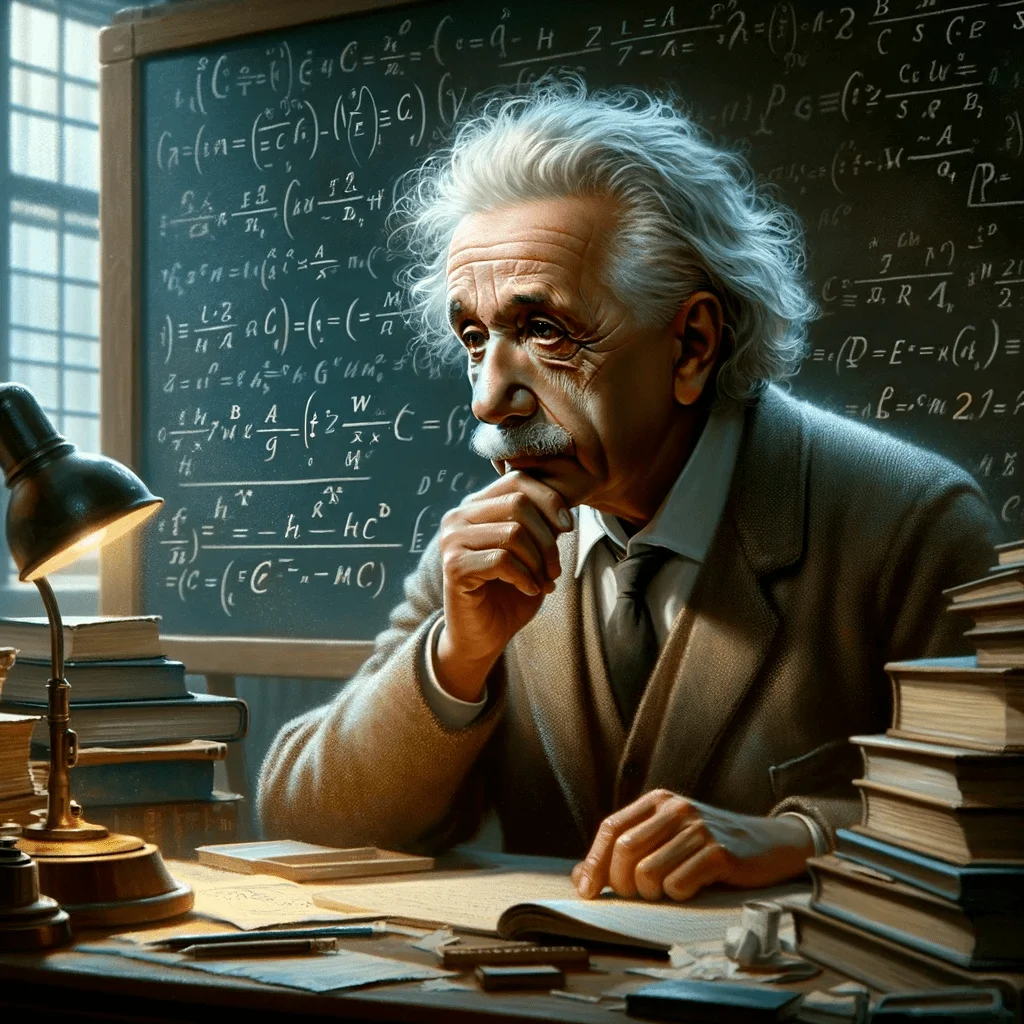Albert Einstein

Albert Einstein was a German-born theoretical physicist who is widely considered one of the most influential scientists of the 20th century. He is best known for his development of the theory of relativity and his equation E=mc², which describes the relationship between mass and energy. Einstein was also a prolific writer and philosopher, and he made significant contributions to the fields of mathematics, astrophysics, and cosmology.
Einstein received his early education in Switzerland and later studied at the Polytechnic in Zurich, where he earned a degree in physics. He went on to work as a patent clerk while pursuing his scientific research. In 1905, he published a series of papers on the photoelectric effect, Brownian motion, and special relativity that revolutionized the field of physics and earned him widespread recognition.
In 1914, Einstein returned to Germany to become a professor at the University of Berlin, where he continued to develop his theories of relativity and quantum mechanics. However, with the rise of the Nazi party in Germany, Einstein emigrated to the United States in 1933 and became a professor at the Institute for Advanced Study at Princeton University.
Einstein’s work on the theory of relativity has been the subject of much speculation and interest in the UFO and UAP communities. Some have suggested that the theory provides a framework for understanding the physics behind the phenomena, while others have claimed that Einstein himself was interested in UFOs.
While there is no direct evidence to support these claims, some researchers have pointed to Einstein’s own statements about the possibility of extraterrestrial life as evidence of his interest in the subject. In a letter to a friend in 1950, he wrote, “I believe that there is life on other planets even though we have no direct evidence, yet.”
Facts about Einstein:
- Einstein’s brain was preserved for study after his death. Researchers have used advanced imaging techniques to study the structure of his brain and have found that it had a greater density of neurons and glial cells in certain areas than the brains of control subjects.
- Einstein was a pacifist and spoke out against war and the use of nuclear weapons. He was a co-founder of the Emergency Committee of Atomic Scientists and was a signatory of the Russell-Einstein Manifesto, which called for an end to nuclear weapons testing and disarmament.
- Einstein was offered the presidency of Israel in 1952 but declined the offer, citing his lack of political experience.
Einstein authored numerous books and articles throughout his life, including “Relativity: The Special and the General Theory” and “The Meaning of Relativity.” He also collaborated with other scientists, such as Nathan Rosen, on papers related to the theory of relativity.
Many books have been written about Einstein, both by him and by others. Some notable examples include “The World As I See It,” a collection of essays and speeches by Einstein, and “Einstein: His Life and Universe” by Walter Isaacson, which provides a comprehensive biography of the scientist.
Einstein’s theories and contributions to science continue to be celebrated and studied. In 2019, the Event Horizon Telescope collaboration released the first-ever image of a black hole, providing visual confirmation of Einstein’s theory of general relativity. Additionally, his work on the photoelectric effect was recognized with the awarding of the 1921 Nobel Prize in Physics.
Albert Einstein was not directly involved in the development of nuclear weapons, but his scientific work did contribute to the research that led to their creation.
In 1939, Einstein wrote a letter to President Franklin D. Roosevelt urging him to begin research on nuclear weapons before Nazi Germany could develop them first. This letter, which was co-signed by physicist Leo Szilard, helped to kickstart the Manhattan Project, which was a research program aimed at developing the first nuclear weapons.
While Einstein did not work directly on the Manhattan Project and was not involved in the actual development of the atomic bomb, his work on the theory of relativity and his famous equation E=mc² were crucial to understanding the physics behind the weapon. In addition, several of Einstein’s former students and colleagues, such as Eugene Wigner and Leo Szilard, were directly involved in the development of the bomb.
After the bombing of Hiroshima and Nagasaki in 1945, Einstein became an outspoken critic of nuclear weapons and called for international control of atomic energy. He was a co-founder of the Emergency Committee of Atomic Scientists and was a signatory of the Russell-Einstein Manifesto, which called for an end to nuclear weapons testing and disarmament.
E=mc² is perhaps the most famous equation in physics and is associated with Albert Einstein and his theory of special relativity. At its core, the equation shows the equivalence of mass and energy and describes the relationship between the two.
The equation is composed of three symbols:
- E represents energy
- m represents mass
- c represents the speed of light in a vacuum, which is approximately 299,792,458 meters per second.
The equation shows that energy and mass are equivalent and can be converted into one another. Specifically, it shows that a small amount of mass can be converted into a large amount of energy, and vice versa.
To understand how this works, it’s important to understand a bit about the concept of mass. Mass is a property of matter that describes how much resistance an object offers to changes in its motion. In other words, the more massive an object is, the harder it is to move it.
According to Einstein’s theory of special relativity, the speed of light is constant in all frames of reference. This means that no matter how fast an observer is moving, they will always measure the speed of light to be the same.
This has some profound implications for the relationship between mass and energy. Specifically, it means that mass is not just a property of matter, but is also a form of energy. In other words, mass is a concentrated form of energy, and this energy can be released and converted into other forms of energy.
The equation E=mc² shows the amount of energy that is equivalent to a given amount of mass. It says that the amount of energy (E) that can be obtained from a given amount of mass (m) is equal to the mass times the speed of light squared (c²). Since the speed of light is such a large number, even a small amount of mass can be converted into a tremendous amount of energy.
For example, the atomic bomb that was dropped on Hiroshima in 1945 converted a small amount of matter (less than a gram) into a massive explosion that released the equivalent of about 15,000 tons of TNT.
E=mc² has had a profound impact on many industries and areas of research, particularly those related to energy and particle physics.
One of the most well-known applications of E=mc² is in the field of nuclear energy. The equation shows that even a small amount of mass can be converted into a tremendous amount of energy, and this principle is the basis for nuclear fission and fusion reactors. In a nuclear reactor, uranium or other radioactive elements are bombarded with neutrons, which causes the atoms to split and release energy in the form of heat. This heat is then used to generate electricity.
E=mc² has also been instrumental in the development of particle accelerators and colliders. These devices accelerate particles to incredibly high speeds and smash them together, releasing vast amounts of energy in the process. This energy can then be used to create and study new particles, which has helped us to better understand the fundamental nature of matter and the universe.
The equation has also had practical applications in fields such as medicine and engineering. For example, it is used in radiation therapy for cancer patients, where high-energy particles are used to destroy cancerous cells. It has also been used to develop new materials and technologies, such as the use of nuclear energy to power space probes and other remote devices.
In addition to its practical applications, E=mc² has had a profound impact on our understanding of the universe and our place within it. It has helped us to understand the nature of energy and matter, and has shown us that these two seemingly distinct concepts are actually deeply intertwined. It has also shown us that the amount of energy in the universe is constant, and that matter and energy can be converted into one another.



